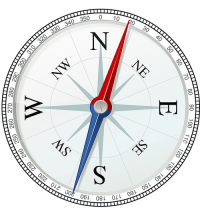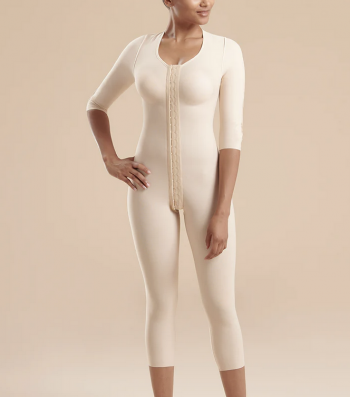How Long Do I Have to Wear My Faja 24/7?
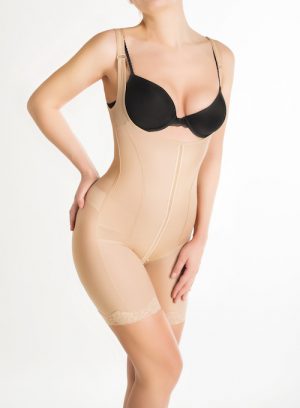
The most common question I get asked about fajas is:
“When can I stop wearing my faja 24/7?”
Wearing your faja is an essential part of a great surgical recovery, so it’s important to understand the ground rules of how long you should wear it – and why.
Let’s start first with why you should wear your faja.
Fajas are designed to provide support for tissues that have been loosened from the muscles underneath after liposuction or a tummy tuck.
Fajas help to shape your body after a cosmetic procedure. As the fascia regrows, it wraps us like saran wrap in the shape that we most often find ourselves. By having a faja to hold us in that shape, the fascia tends to grow in the desired pattern.
Finally, fajas also act to resist swelling. (For more information on how swelling happens at a microscopic level, watch this video on the lymphatic system.)
Quick Comparison: Stage 1 vs Stage 2 Fajas
So we are all on the same page, we also need to know the difference between a Stage 1 and a Stage 2 faja.
Your Stage 1 faja will be provided to you at the time of your surgery. It is usually not very tight and it is very stretchy. Right after surgery (roughly the first 7-10 days), your body needs to have a bit of swelling to facilitate the repair process.
Adding too much pressure too fast is like adding a second trauma to the tissue, so don’t be concerned that your first faja feels not much different than the leotard you wore in 6th grade for gymnastics class. For the first week or so, this is an appropriate degree of compression. Also, the blood vessels that have been damaged during surgery need this time to regrow to support the tissues. They need a little “breathing room” for a week or two.
When it’s time to transition to your Stage 2 faja, then it’s important to pay attention to the amount of resistance that the fabric has in addition to the tightness. These two factors combined are what keep the swelling down.
How Fajas Keep Swelling in Check
Your faja helps to keep your swelling under control by applying pressure and by providing resistance.
What is meant by pressure?
The pressure part corresponds to how tight the faja is. It’s easy to judge how tight your faja is. Can you pinch it and pull it away from your body easily? If so, your faja isn’t tight enough. Add foam, have the faja taken in, or reduce to a smaller faja.
While tightness is important, it is only part of the picture. Resistance is a different quality that is important to understand to make sure you have the right faja.
So, what do I mean by resistance?
Let’s take an example of nitrile gloves, like a doctor would wear. If you were to take one of these gloves and blow it up like a balloon, you could do it easily.
Now imagine a dishwashing glove. If you were to try to blow up the dishwashing glove, you’d probably blow out your lungs in the process. The reason? The material is stronger and it can resist the force of the air you are trying to put into it.
Taking that example and translating it to how a faja resists swelling. The body is trying to push fluid out of the bloodstream into the tissues. If there is no resistance (nitrile glove/Stage 1 faja), a lot of fluid comes out. If there is a good deal of resistance (dishwashing glove/Stage 2 faja), less fluid comes out.
Having a Little Swelling Is Not Bad
To be clear, you need a little bit of swelling. The fluid is an important part of how the body repairs itself. Food is carried out of the bloodstream to the cells with this fluid. When cells are well-nourished and can repair themselves.
There are also lots of other repair mechanisms that are delivered by the body to the surgical area through the fluid that causes swelling. So, don’t get upset if you have a bit of swelling even with a good-fitting, high-resistance faja. It’s normal, and is part of the healing process.
So, How Long Do You Have to Wear Your Faja?
I’ve already addressed the Stage 1 faja. You should wear it about 7-10 days.
Stage 2 is not as straightforward. This is because some people have more swelling and others have less severe swelling, so there is not one absolute answer that fits everyone.
So, the advice here is for most people – the people in the middle who don’t have excessive swelling or very little swelling. If you are one of the people who is in one of those extremes, you may wear your faja longer or for a slightly shorter duration of time.
Guidelines for Most People
For the majority of people who get lipo, tummy tuck, and or BBL surgery, you should plan to wear your faja for a solid 8 weeks, 23 hours a day – yes, that’s with foams and all. You get one hour to bathe yourself and wash your faja. That’s it. Stick to these guidelines and you will get the best results possible.
I know that you feel like the Stay Puff Marshmallow Man from Ghostbusters wearing all that stuff. You got plastic surgery so that you could look amazing in your clothes, and you are eager to show off your new look. Now is not the time. If you want to look good in the long-term, you have to suck it up for a couple of months first. If you are still planning your surgery, you might want to think about winter as a better time because it’s easier to hide all the foams under a sweater.
If you are just starting out wearing your Stage 2 faja, it will feel uncomfortable initially. It is a lot of stimulation over a large area of the body. It will be all you think about at first, but you will get used to it.
Think about when you first had your ears pierced. You were acutely aware of them. You felt them without thinking about it. After they healed up and you had worn them for a week or so, you got to where you didn’t really notice the earrings in your ears. Wearing a faja is the same. You not only will get used to it, but you will want to wear it – I promise! Most people say that they “feel naked without it.” So if you are having a hard time getting used to it, trust that it will become a normal and comfortable feeling.
Can I Take My Faja Off For a Few Hours?
To be sure, wearing a faja can get tiring. It’s much like wearing a bra. You can’t wait until you can take it off when you get home. No one wants to wear their faja 24/7. People often want to sleep without their fajas, but it isn’t a good idea in the first couple of months of recovery.
The thing about (good) fajas that is different is that after you take it of for 10 minutes or so, you can’t wait to put it back on again! Crazy, right? Not really. Your body needs that support – especially in the first several weeks after surgery.
So, can you take off your faja for a few hours? Well, that depends. Typically people who don’t have a tremendous amount of swelling (usually folks who were fairly small prior to surgery) can get away with it a little easier than someone who had more excess fat prior to surgery. Why? They swell a lot less on average.
Someone who swells a lot less can find compression to be more uncomfortable than someone with a lot of swelling. Compression without swelling can be very uncomfortable.
If you are a person who doesn’t have much swelling, you might be able to give yourself an hour or two out of it. If your swelling is moderate or severe, you should probably stick to the 23/7 rule of keeping it on – at least until your swelling improves significantly.
Transitioning After the First 8 Weeks
After the first 8 weeks have passed, most people will be able to begin experimenting with wearing their faja for shorter periods of time. Notice that I didn’t say that you can quit wearing it altogether.
If your swelling has become more manageable, then your faja may go from feeling comfortable to becoming uncomfortable at times. Compression when you don’t have swelling is uncomfortable. This is when you will want to begin transitioning out.
How to Transition Out of Wearing Your Faja
Around the 8 week mark or later, go ahead and try taking your faja off for 8-12 hours and see what happens. You will probably have some swelling – and that is expected.
When you go to put back on your faja, was it a little more difficult or a lot more difficult? If it was a lot more difficult, then you probably need to try wearing it for another week 23 hours a day and try again.
If it was only a little more difficult, then you are probably on the right track. Some swelling is expected. Now what you want to do is try to experiment with the best time of day or night to have the faja off.
Generally speaking, swelling tends to happen in the body mostly in the arms and legs during the day because they are hanging down. When we go to sleep, the fluid from our arms and legs returns to our trunk, head, and neck. So people who have swelling in those areas seem to experience more problems there at night. Because of this, many people find that wearing the faja overnight works best, but this doesn’t work for everyone.
Some people have desk jobs and other people have jobs that require a great deal of activity. When we are actively doing work with our bodies (like working out), we swell. So, someone who is very active may be better off wearing her faja during the day.
Experiment, play around, and see what works best for you.
Regarding foams and boards after the first 8 weeks, you can likely quit wearing the boards. Foams should be worn with the faja if the faja creases into your skin. You may find that you only need some foam instead of 360 foam. The foam is most important at this stage for people who really have a lot of swelling still going on. When the swelling isn’t a real problem anymore, you can get rid of the foam.
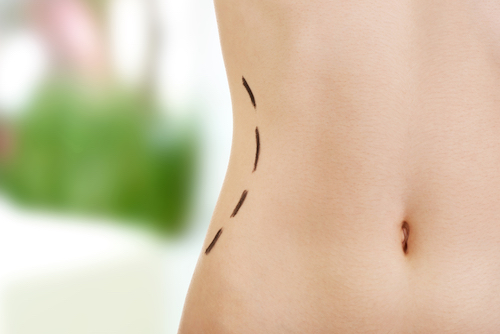
The Long Term
So, when can you totally stop wearing your faja? Again, the answer is different for everyone. The general rule is that the longer you wear it over the year of healing after your surgery, the better your results will be.
You were probably told by your surgeon that the healing process takes a year. It really does. Sure, by 3 months you are going to probably be pretty happy with what you are seeing, but the body is still doing work behind the scenes to repair the damage done during surgery.
Wearing your faja regularly will help the body by physically supporting the shape that you want. We have a tissue called fascia that shrink wraps us and helps hold us together. (This is the white, web-like tissue you see when you peel the skin off of a chicken breast.) It grows in the shape we find ourselves in the most. If you wear your faja daily for a year, then you will be in that ideal shape most of the time.
While most people won’t wear a faja every single day for a year, it is a goal that you can aspire to. Do your best to wear it as often as you can for the rest of the first year.
Eventually, you won’t need to wear your faja anymore unless you just really want to.
Hang in there! The effort is worth it!
Suggested Fajas
If you are searching for a better-fitting Stage 2 faja, here are some Amazon links to the ones I carry in my practice. My preference is the CYSM brand. It tends to fit women who are more curvy. Most styles of M&D are better suited for more slender builds.
CYSM Fajas

CYSM Fajas Colombianas –
Typically fit curvier ladies very well and are pretty true to size.
______________________________________
M&D Fajas
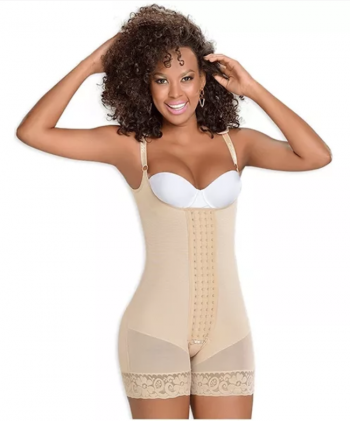
Get MyD Stage 2 Fajas on amazon
MyD fajas typically fit very slender women best.
While these are a great option, they run very, very small.
A woman who wears a size 6 pant might wear a 2XL!
______________________________________
